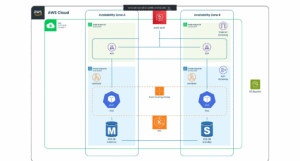Imagine, Sarah Johnson, the Chief Information Security Officer at a leading smart home company, sits in her office, her brow furrowed in concentration. She’s not pondering the latest barbecue joint or live music venue; instead, her mind is occupied with a far more pressing concern: the escalating threat of malware targeting Internet of Things (IoT) devices.
As our homes and offices become increasingly connected, with everything from thermostats to refrigerators now boasting internet capabilities, a new frontier in cybersecurity has emerged. The convenience of IoT devices comes with a price – vulnerability to malicious attacks that can compromise not just individual privacy, but entire networks and even critical infrastructure.
“The landscape of IoT security is evolving at a breakneck pace. We’re seeing a quadrupling of malware attacks against IoT devices, and it’s clear that traditional security measures are no longer sufficient.”
The Rising Tide of IoT Malware
Recent data from cybersecurity firms paints a sobering picture. Malware attacks targeting IoT devices have increased fourfold, with over 100 million attacks detected in the first half of 2019 alone. This surge in malicious activity is not just a matter of scale, but also of sophistication.
Cybercriminals are developing increasingly complex malware specifically designed to exploit the unique vulnerabilities of IoT devices. These attacks can range from relatively benign pranks, like changing the temperature on a smart thermostat, to far more sinister actions, such as hijacking security cameras or infiltrating industrial control systems.
The reasons behind this surge are multifaceted. IoT devices often lack robust built-in security measures, making them low-hanging fruit for attackers. Additionally, the sheer number of connected devices – estimated to reach 75 billion by 2025 – provides an expansive attack surface for malicious actors.
Understanding IoT Malware: A New Breed of Threat
IoT malware differs from traditional computer viruses in several key ways. These malicious programs are often designed to operate on devices with limited processing power and memory, making them more challenging to detect and remove. They can also spread rapidly across networks of connected devices, creating large-scale botnets capable of launching devastating distributed denial-of-service (DDoS) attacks.
Some of the most common types of IoT malware include:
- Mirai: A notorious botnet that infects IoT devices with weak security credentials.
- BrickerBot: Malware designed to render devices inoperable, often as a misguided attempt at “security through destruction.”
- Hajime: A sophisticated worm that spreads through unsecured IoT devices, though its ultimate purpose remains unclear.
- VPNFilter: A multi-stage, modular malware platform that targets networking equipment.
“The diversity of IoT malware reflects the creativity of cybercriminals. They’re constantly developing new ways to exploit these devices, often faster than manufacturers can patch vulnerabilities.”
The Anatomy of an IoT Malware Attack
To understand how to defend against IoT malware, it’s crucial to comprehend how these attacks typically unfold. The process often follows a predictable pattern:
- Reconnaissance: Attackers scan for vulnerable devices, often using automated tools to identify potential targets.
- Exploitation: Once a vulnerable device is found, the attacker exploits known security flaws or weak credentials to gain access.
- Payload Delivery: Malware is uploaded to the compromised device, often disguised as legitimate firmware updates.
- Command and Control: The infected device establishes communication with the attacker’s command and control server.
- Lateral Movement: The malware spreads to other devices on the network, expanding the attacker’s foothold.
- Data Exfiltration or Attack Launch: Depending on the attacker’s goals, the compromised devices may be used to steal data or launch further attacks.
Fortifying the IoT Frontier: Best Practices for Protection
Defending against IoT malware requires a multi-layered approach that combines technological solutions with sound security practices. Here are some key strategies recommended by experts:
1. Secure Network Segmentation
One of the most effective ways to contain potential IoT malware infections is through network segmentation. By isolating IoT devices on separate network segments or VLANs, organizations can limit the spread of malware and protect critical systems.
“Think of it as creating digital quarantine zones. If one IoT device becomes infected, it doesn’t have free rein over your entire network.”
2. Regular Firmware Updates and Patch Management
Many IoT malware attacks exploit known vulnerabilities that have already been patched by manufacturers. Establishing a rigorous update and patch management process is crucial for closing these security gaps.
“Treat your IoT devices with the same diligence you apply to your computers and smartphones. Regular updates are your first line of defense against emerging threats.”
3. Strong Authentication and Access Controls
Weak or default passwords remain one of the primary attack vectors for IoT malware. Implementing strong, unique passwords for each device and enabling two-factor authentication where possible can significantly reduce the risk of unauthorized access.
4. Network Monitoring and Anomaly Detection
Deploying advanced network monitoring tools that can detect unusual traffic patterns or behavior from IoT devices is essential for early threat detection. Machine learning-powered systems can help identify potential malware infections before they spread.
5. Device Inventory and Management
Maintaining a comprehensive inventory of all IoT devices on your network is crucial for effective security management. This includes documenting device types, firmware versions, and associated vulnerabilities.
“You can’t protect what you don’t know about. A thorough device inventory is the foundation of any robust IoT security strategy.”
6. Vendor Security Assessment
Before deploying new IoT devices, organizations should conduct thorough security assessments of vendors and their products. This includes reviewing their security practices, update policies, and track record in addressing vulnerabilities.
7. Employee Education and Awareness
Human error remains a significant factor in many security breaches. Regular training sessions on IoT security best practices can help employees understand the risks and their role in maintaining a secure environment.
The Future of IoT Security: Challenges and Opportunities
As the IoT ecosystem continues to expand, the challenge of securing these devices will only grow more complex. However, this challenge also presents opportunities for innovation in the cybersecurity field.
“We’re seeing exciting developments in AI-powered security solutions and blockchain-based IoT authentication systems. These technologies have the potential to revolutionize how we approach IoT security.”
Regulatory bodies are also taking notice of the IoT security landscape. The introduction of legislation like the IoT Cybersecurity Improvement Act in the United States signals a growing recognition of the need for standardized security measures in IoT devices.
A Collective Responsibility
As our world becomes increasingly interconnected, the security of IoT devices is no longer just a concern for IT departments or tech enthusiasts. It’s a collective responsibility that impacts individuals, businesses, and society as a whole.
“Defending against IoT malware is not just about protecting data or devices. It’s about safeguarding the digital infrastructure that increasingly underpins our daily lives.”
By understanding the threat landscape, implementing robust security measures, and staying vigilant, we can harness the full potential of IoT technology while mitigating the risks posed by malware. As we stand on the cusp of a fully connected world, the importance of IoT security has never been greater – and neither has the opportunity to shape a safer digital future.
You may also be interested in: 13 PCI Compliance Solutions That Protect Sensitive Payment
Eliminate DevOps hiring needs. Deploy secure, compliant infrastructure in days, not months. Accelerate your launch and growth by avoiding tedious infrastructure tasks. Join thousands of Dev teams getting their time back. Leverage DuploCloud DevOps Automation Platform, backed by infrastructure experts to automate and manage DevOps tasks. Drive savings and faster time-to-market with a 30-minute live demo
.



